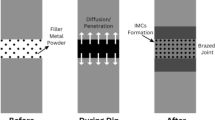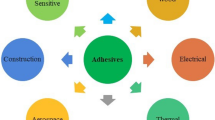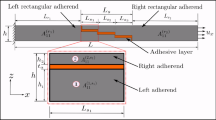Abstract
Nano-technological developments, which have made significant progress in recent years, have significant impact on the science of adhesives. Therefore, in our study, the static and fatigue strengths of single-lap joints (SLJs) incorporating nanoparticles were compared to those without nanoparticles. Steel plates were used in the adhesive joints. The results revealed that average damage load increased significantly in nanoparticle-reinforced adhesive joints. The highest damage load was obtained with 4 wt% nano-Al2O3 in epoxy adhesive. As the average damage load increased, the locus of damage changed from interfacial to the mixture of interfacial and cohesive. Also, fatigue strengths of the joints increased when the adhesive joint had nano-Al2O3 and nano-SiO2, and decreased when the adhesive joint had nano-TiO2.




Similar content being viewed by others
References
Ünal E (2006) Simulation of fatigue of glass fibre composite materials in atmospheric environment and sea environment. Graduate Thesis, Ege University Institute of Science and Technology, İzmir
Turan K, Pekbey Y (2015) Progressive failure analysis of reinforced-adhesively single-lap joint. J Adhes 91:962–977. https://doi.org/10.1080/00218464.2014.985379
Solmaz MY, Topkaya T (2013) Progressive failure analysis in adhesively, riveted, and hybrid bonded double-lap joints. J Adhes 89:822–836. https://doi.org/10.1080/00218464.2013.765800
Özer H, Öz Ö (2012) Three dimensional finite element analysis of bi-adhesively bonded double lap joint. Int J Adhes Adhes 37:50–55. https://doi.org/10.1515/jtam-2015-0019
Adin H, Turgut A (2012) Strength and failure analysis of inverse Z joints bonded with Vinylester Atlac 580 and Flexo Tix adhesives. J Mech Sci Technol 26:3453–3461. https://doi.org/10.1007/s12206-012-0873-x
Çalık A (2016) Effect of adherend shape on stress concentration reduction of adhesively bonded single lap joint. Eng Rev 36(1):29–34
Li W, Blunt L, Stout KJ (1997) Analysis and design of adhesive-bonded tee joints. Int J Adhes Adhes 17:303–311. https://doi.org/10.1016/S0143-7496(97)00012-2
Domingues NRE, Campilho RDSG, Carbas RJC, da Silva LFM (2016) Experimental and numerical failure analysis of aluminium/composite single-L joints. Int J Adhes Adhes 64:86–96. https://doi.org/10.1016/j.ijadhadh.2015.10.011
Çalık A, Yıldırım S (2017) Effect of adherend recessing on bi-adhesively bonded single-lap joints with spew fillet. Sadhana 42:317–325. https://doi.org/10.1007/s12046-017-0603-2
Tosun E, Çalık A (2016) Failure load prediction of single lap adhesive joints using artificial neural networks. Alex Eng J 55:1341–1346. https://doi.org/10.1016/j.aej.2016.04.029
Thawre MM, Pandey KN, Dubey A, Verma KK, Peshwe DR, Paretkar RK (2015) Fatigue life of a carbon fibre composite T-joint under a standard fighter aircraft spectrum load sequence. Compos Struct 127:260–266. https://doi.org/10.1016/j.compstruct.2015.03.026
Çitil Ş, Ayaz Y, Temiz Ş (2017) Stress analysis of adhesively bonded double strap joints with or without intermediate part subjected to tensile loading. J Adhes 93(5):343–356. https://doi.org/10.1080/00218464.2015.1075885
Özel A, Yazıcı B, Akpınar S, Aydın MD, Temiz Ş (2014) A study on the strength of adhesively bonded joints with different adherends. Compos Part B 62:167–174. https://doi.org/10.1016/j.compositesb.2014.03.001
Çitil Ş (2017) Comparison of stepped, curved, and S-Type lap joints under tensile loading. In: da Silva Lucas FM (ed) Materials Design and Applications. Springer, Porto, pp 377–388
Gültekin K, Akpınar S, Özel A (2014) The effect of the adherend width on the strength of adhesively bonded single-lap joint: experimental and numerical analysis. Compos Part B 60:736–745. https://doi.org/10.1016/j.compositesb.2014.01.022
Çitil Ş, Ayaz Y, Temiz Ş, Aydın MD (2017) Mechanical behaviour of adhesively repaired pipes subject to internal pressure. Int J Adhes Adhes 75:88–95. https://doi.org/10.1016/j.ijadhadh.2017.02.015
Çitil S, Temiz S, Altun H, Özel A (2011) Determination of mechanical properties of double strap adhesive joints with an embedded patch. J Adhes Sci Technol 25:2555–2567. https://doi.org/10.1163/016942411X580225
Fernando M, Harjoprayitno WW, Kinloch AJ (1996) A fracture mechanics study of the influence of moisture on the fatigue behaviour of adhesively bonded aluminium-alloy joints. Int J Adhes Adhes 16:113–119. https://doi.org/10.1016/0143-7496(96)89799-5
Ferreira JAM, Reis PN, Costa JDM, Richardson MOW (2002) Fatigue behaviour of composite adhesive lap joints. Compos Sci Technol 62:1373–1379. https://doi.org/10.1016/S0266-3538(02)00082-9
Dessureault M, Spelt JK (1997) Observations of fatigue crack initiation and propagation in an epoxy adhesive. Int J Adhes Adhes 17:183–195. https://doi.org/10.1016/S0143-7496(96)00044-9
Blanchard C, Chateauminois A, Vincent L (1996) A new testing methodology for the assessment of fatigue properties of structural adhesives. Int J Adhes Adhes 16:289–299. https://doi.org/10.1016/S0143-7496(96)00018-8
Abou-Hamda MM, Megahed MM, Hammouda MMI (1998) Fatigue crack growth in double cantilever beam specimen with an adhesive layer. Eng Fract Mech 60:605–614. https://doi.org/10.1016/S0013-7944(98)00018-6
De Goeij WC, Van Tooren MJL, Beukers A (1999) Composite adhesive joints under cyclic loading. Mater Des 20:213–221. https://doi.org/10.1016/S0261-3069(99)00032-1
A.D C, G R (1999) Assessing stress state and mean load effects on the fatigue response of adhesively bonded joints. Int J Adhes Adhes 19:19–27. https://doi.org/10.1016/S0143-7496(98)00049-9
Imanaka M, Nakayama H, Morikawa K, Nakamura M (1995) Evaluation of fatigue life of adhesively bonded CFRP pipe/steel rod joints. Compos Struct 31:235–241. https://doi.org/10.1016/0263-8223(95)00015-1
Knox EM, Cowling MJ, Hashim SA (2000) Fatigue performance of adhesively bonded connections in GRE pipes. Int J Fatigue 22:513–519. https://doi.org/10.1016/S0142-1123(00)00015-3
Fu M, Mallick PK (2001) Fatigue of hybrid (adhesive/bolted) joints in SRIM composites. Int J Adhes Adhes 21:145–159. https://doi.org/10.1016/S0143-7496(00)00047-6
Quaresimin M, Ricotta M (2006) Fatigue behaviour and damage evolution of single lap bonded joints in composite material. Compos Sci Technol 66:176–187. https://doi.org/10.1016/j.compscitech.2005.04.026
Jen YM, Ko CW (2010) Evaluation of fatigue life of adhesively bonded aluminium single-lap joints using interfacial parameters. Int J Fatigue 32:330–340. https://doi.org/10.1016/j.ijfatigue.2009.07.001
Gültekin K, Akpınar S, Gürses A, Eroğlu Z, Özel A (2016) The effects of graphene nanostructure reinforcement on the adhesive method and the graphene reinforcement ratio on the failure load in adhesively bonded joints. Compos Part B 98:362–369. https://doi.org/10.1016/j.compositesb.2016.05.039
Akpınar IA, Gültekin K, Akpınar S, Akbulut H, Özel A (2017) Experimental analysis on the single-lap joints bonded by a nanocomposite adhesives which obtained by adding nanostructures. Compos Part B 110:420–428. https://doi.org/10.1016/j.compositesb.2016.11.046
Ekrem M, Avcı A (2018) Effects of polyvinyl alcohol nanofiber mats on the adhesion strength and fracture toughness of epoxy adhesive joints. Compos Part B 138:256–264. https://doi.org/10.1016/j.compositesb.2017.11.049
Meguid SA, Sun Y (2004) On the tensile and shear strength of nano-reinforced composite interfaces. Mater Des 25:289–296. https://doi.org/10.1016/j.matdes.2003.10.018
Zhai L, Ling G, Li J, Wang Y (2006) The effect of nanoparticles on the adhesion of epoxy adhesive. Mater Lett 60:3031–3033. https://doi.org/10.1016/j.matlet.2006.02.038
Zhai L, Ling G, Li J, Wang Y (2008) Effect of nano- Al2O3 on adhesion strength of epoxy adhesive and steel. Int J Adhes Adhes 28:23–28. https://doi.org/10.1016/j.ijadhadh.2007.03.005
Srivastava VK (2011) Effect of carbon nanotubes on the strength of adhesive lap joints of C/C and C/C–SiC ceramic fibre composites. Int J Adhes Adhes 31:486–489. https://doi.org/10.1016/j.ijadhadh.2011.03.006
Khashaba UA, Aljinaidi AA, Hamed MA (2015) Development of CFRE composite scarf adhesive joints with SiC and Al2O3 nanoparticle. Compos Struct 128:415–427. https://doi.org/10.1016/j.compstruct.2015.03.071
Saraç I, Adin H, Temiz Ş (2019) Investigation of the effect of use of nano-Al2O3, nano-TiO2 and nano-SiO2 powders on strength of single lap joints bonded with epoxy adhesive. Compos Part B 166:472–482. https://doi.org/10.1016/j.compositesb.2019.02.007
Kang MH, Choi JH, Kweon JH (2014) Fatigue life evaluation and crack detection of the adhesive joint with carbon nanotubes. Compos Struct 108:417–422. https://doi.org/10.1016/j.compstruct.2013.09.046
Funding
We are grateful to Batman University Scientific Research Projects (BAP) Coordination for providing financial support for the realization of our work (Project number: BTÜBAP-2016-PhD-2).
Author information
Authors and Affiliations
Corresponding author
Additional information
Publisher’s note
Springer Nature remains neutral with regard to jurisdictional claims in published maps and institutional affiliations.
Recommended for publication by Commission XIII - Fatigue of Welded Components and Structures
Rights and permissions
About this article
Cite this article
Saraç, İ., Adin, H. & Temiz, Ş. A research on the fatigue strength of the single-lap joint joints bonded with nanoparticle-reinforced adhesive. Weld World 65, 635–642 (2021). https://doi.org/10.1007/s40194-020-01063-2
Received:
Accepted:
Published:
Issue Date:
DOI: https://doi.org/10.1007/s40194-020-01063-2




